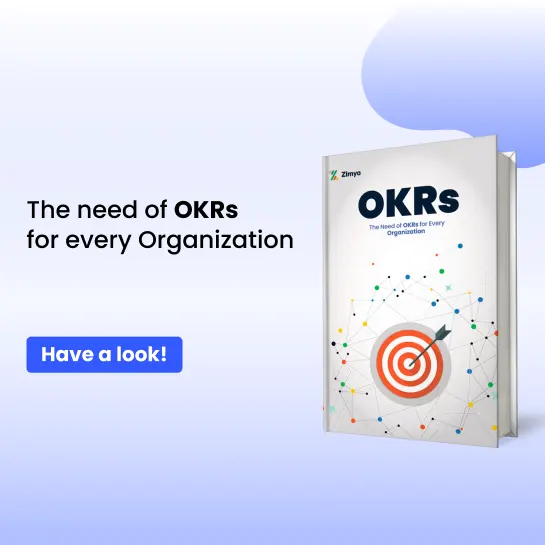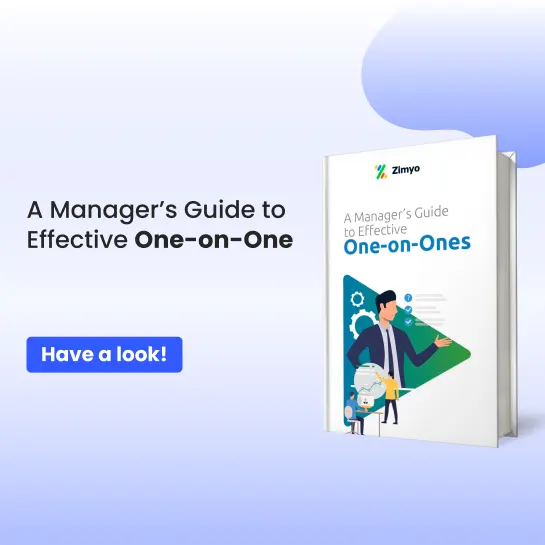In this fast-evolving world, learning only pauses briefly. At school, university, or even the corporation, individuals must continually refresh their knowledge. That’s where a learning management system (LMS) fits in.
The need for the top learning management system has increased significantly over the past few years with the transition to remote work, e-learning, and digital transformation. Whether onboarding new hires or conducting compliance training or even preparing students for exams, an LMS has become the nucleus of organized learning.
For companies, the appropriate LMS can save them time and money and ensure that all workers receive the same level of training. For instructors and training centers, it provides a virtual classroom in which learning is available, measurable, and more interactive.
This blog will guide you through it all, step by step: what a learning management system actually is, why organizations require the best learning management software in India.
What Learning Management Software?
Learning Management Software (LMS) is a virtual learning hub. It is a computer program that holds, presents, and monitors learning and training courses. Rather than working with fractured files, printed manuals, or classroom sessions, an LMS keeps everything organized in one location.
Fundamentally, a learning and management system enables you to:
- Develop training content (videos, PDFs, slides, quizzes).
- Share this content with students anytime, anywhere.
- Monitor who has completed training and how well they did.
- Issue certificates, marks, and learning tracks.
Some of the terms that you will probably be familiar with are:
- LMS portals – the sign-in page where students and instructors view content.
- Learning management solutions – integrated systems that encompass creation, delivery, and analytics.
- Enterprise LMS – sophisticated platforms for big businesses with thousands of learners.
List of Top Learning Management Software
Here is the list of best chosen LMS solutions in the market:
- Zimyo
- Disprz
- EdisonOS
- Moodle
- Paradiso
- Talent LMS
- iSpring Learn
- Docebo
- Litmos
- SAP SuccessFactors Learning
- Adobe Learning Manager (formerly Captivate Prime)
- Zoho Learn
Top 12 Best Learning Management Software in India: In Depth Analysis
Below are 12 widely used best LMS platforms you can consider. Each short profile highlights what it does best and who it suits.
1. Zimyo
Zimyo is a home-grown Indian HR-tech platform that includes a built-in learning management system module. It aims to integrate HR processes (payroll, performance, attendance) with training so that learning is not isolated but part of the larger employee lifecycle. Zimyo also markets its LMS as “next-gen, AI-powered” with individualized learning recommendations.
Because it is developed in India, it may better suit local compliance needs, language requirements, and integration with Indian HR workflows.
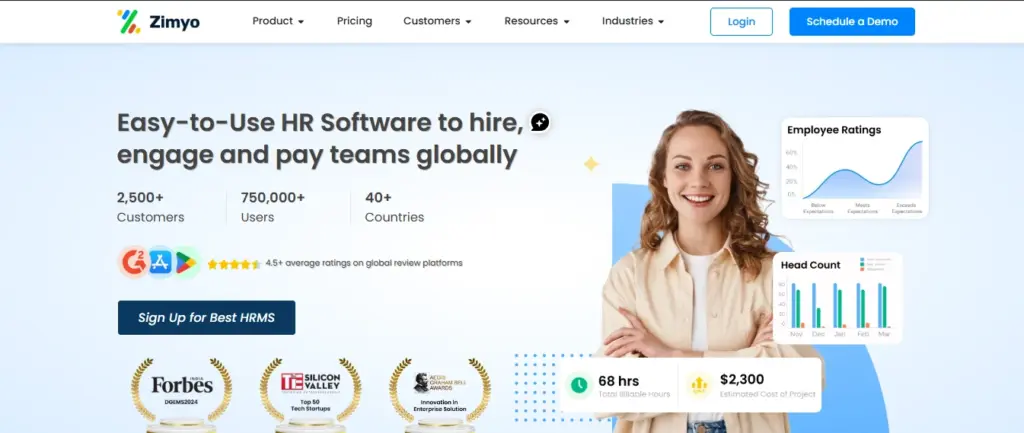
Key Features
- Course creation, assignment, progress tracking and reporting.
- Competency mapping and skill-gap analysis.
- Integration with HRMS modules (attendance, performance, payroll) so that training status feeds into broader HR workflows.
- Gamification features (badges, certificates) and reward recognition tools.
- Analytics and dashboards for learner progress, course effectiveness.
- Multi-lingual support and AI-based recommendation of learning paths.
Pros
- Because it’s integrated with the HR ecosystem, it reduces duplication of data and admin effort.
- Local provider: easier support, understanding of Indian compliance, billing, languages.
- Good for companies looking for an all-in-one HR + learning solution.
- Smart features like competency mapping and AI suggestions help align training to roles.
Cons
- The LMS module may not be as specialized or mature as niche global LMS tools focused solely on learning.
- For very large enterprises with complex global operations, some features or scalability may lag behind global heavyweights.
- As with any platform combining many modules, flexibility or depth in one module might come at the cost of simplicity.
2. Disprz
Disprz is an Indian SaaS company focusing on enterprise learning and skilling. It positions itself not just as an LMS but as a performance-linked, AI-driven learning and skilling platform.
Disprz is mobile-first, emphasizes microlearning and adaptability, and tries to connect learning outcomes directly to business metrics.

Key Features
- Adaptive, multi-channel learning: supports mobile, video, quizzes, microlearning modules.
- Goal-oriented and performance-centric learning: linking learning paths to KPIs.
- Strong analytics and reporting, skill gap analysis.
- Classroom & blended learning support (online + in-person).
- Integration capabilities: HRMS, CRM, communication and conferencing tools.
- Gamification, leaderboards, badges, interactive UI.
- Multi-lingual support (20+ languages) for diverse learners.
Pros
- Very modern, user-friendly, and mobile-first, which makes adoption smoother.
- Strong alignment with business goals, not just tracking courses but focusing on skill outcomes.
- Flexible content types and blended delivery.
- Deep analytics help L&D teams see ROI and impact of training.
- Local (India) presence with global reach.
Cons
- Some advanced or premium features may require add-ons or higher-tier plans.
- Because it’s feature rich, the learning curve (for admin or designers) may be steeper.
- Pricing for large scale or full-featured use might be high for smaller firms.
3. EdisonOS
I could not find as much public data with deep reviews for EdisonOS in India compared to Zimyo or Disprz, but here’s a general structure that you can adapt once you obtain details:
EdisonOS is a platform oriented toward creators, educators, and institutions. It allows building, managing, and selling online courses, membership sites, and educational programs. It combines LMS + community + monetization features.
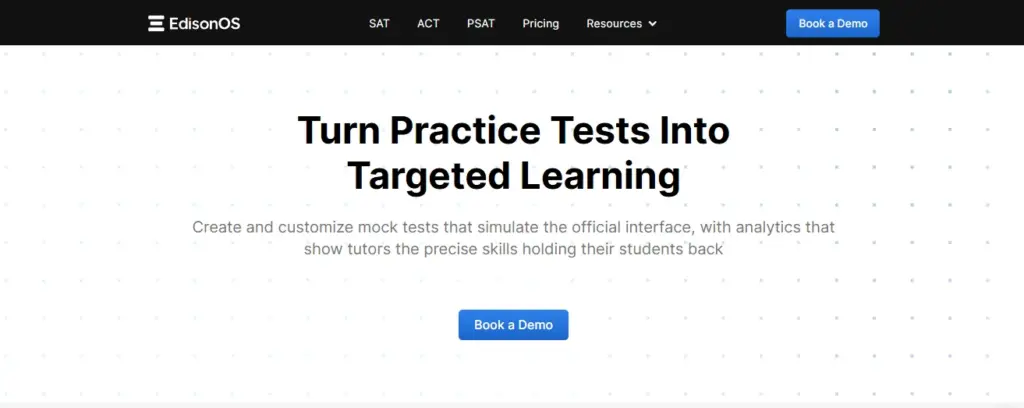
Key Features
- Course builder (lessons, modules, quizzes)
- Membership and subscription management
- Community or discussion forums for learners
- Drip content (content release over time)
- Payment, checkout and monetization tools
- Analytics and learner progress tracking
- Integration with video, email, and marketing tools
Pros
- Great for course creators, coaches and small education businesses.
- Monetization built-in, so you can sell courses.
- Communities and discussion enhancements increase learner engagement.
- Flexible and suited for content-driven delivery.
Cons
- Not as enterprise-focused; may lack features like large scale user management, heavy compliance, or HR integration.
- Customization, performance analytics and advanced integrations may be limited compared to full LMS platforms.
- As with many niche tools, support and scalability in India might depend on their presence and partner network.
4. Moodle
Moodle is a long-established open-source LMS used globally by universities, schools, and corporates. Because it’s open-source, it allows high customization and control. You host it yourself or pay hosting providers.
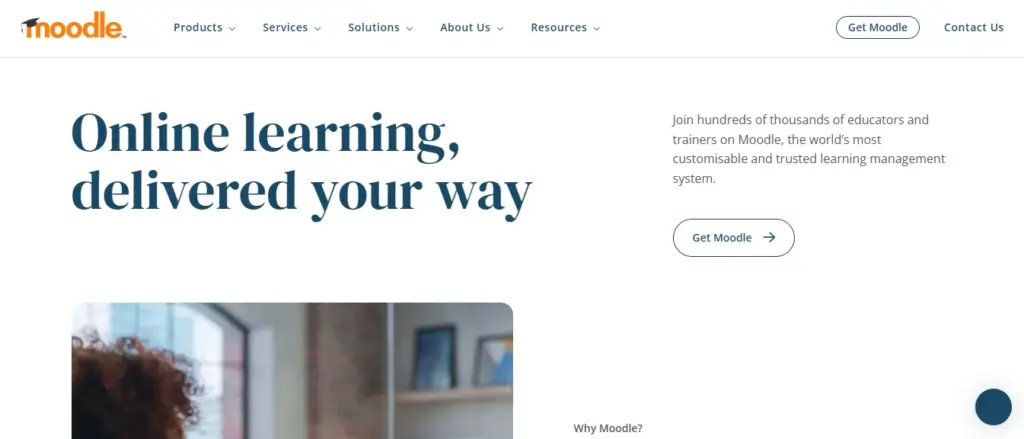
Key Features
- Course and quiz engine, assignments, forums
- Wide plugin ecosystem (themes, modules)
- SCORM, xAPI support
- Flexible roles and permissions
- Blended learning, workshops, peer assessment
- Strong community and open integrations
Pros
- Very flexible and customizable (you can build nearly anything).
- Low licensing costs (open source), only hosting and customization cost.
- Strong community support and many third-party plugins.
- Ideal for educational institutions or organizations wanting full control.
Cons
- Requires technical setup, hosting, maintenance, and often skilled developers.
- User interface can feel dated unless customized.
- Some advanced corporate features (gamification, analytics) may need plugins or additions.
- Upgrades and plugin compatibility can be tricky in large installations.
5. Paradiso
Paradiso is a cloud-based LMS that supports corporate and e-learning organizations. It aims to combine user-friendliness with enterprise-level features, and often positions itself as a full solution for blended training.
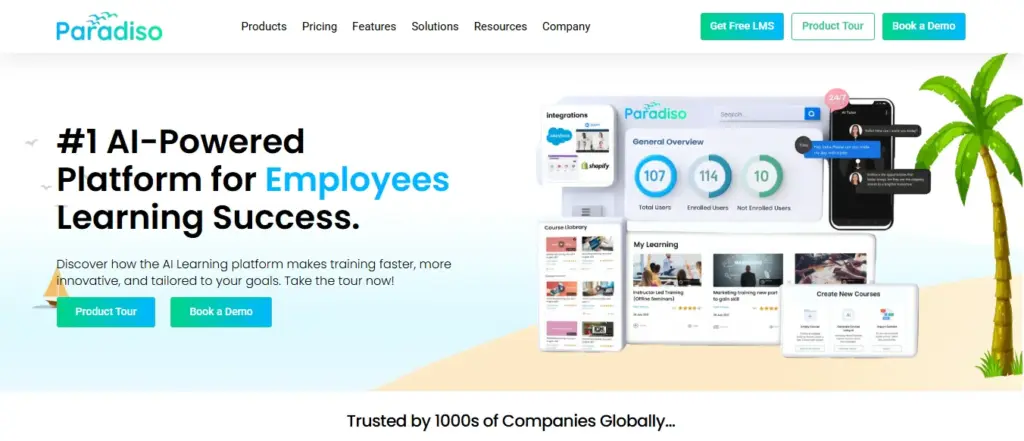
Key Features
- Course authoring and management
- Gamification, badges, points
- Social learning and communities
- SCORM / xAPI / LMS interoperability
- Mobile learning support
- Integrations with HR, CRM, and third-party tools
- Multi-tenant and extended enterprise support
Pros
- Balanced for both corporate training and blended deliveries.
- Good UI and modern design.
- Strong in integration and flexible setup.
- Can support learning for customers, partners as well (extended enterprise).
Cons
- May lack some ultra-high end analytics or very large enterprise scaling features compared to top-tier enterprise LMS.
- Customization might come at additional cost.
6. Talent LMS
TalentLMS is a cloud-based SaaS platform known for being easy to set up, intuitive, and quick to roll out. It is popular with small to medium businesses.
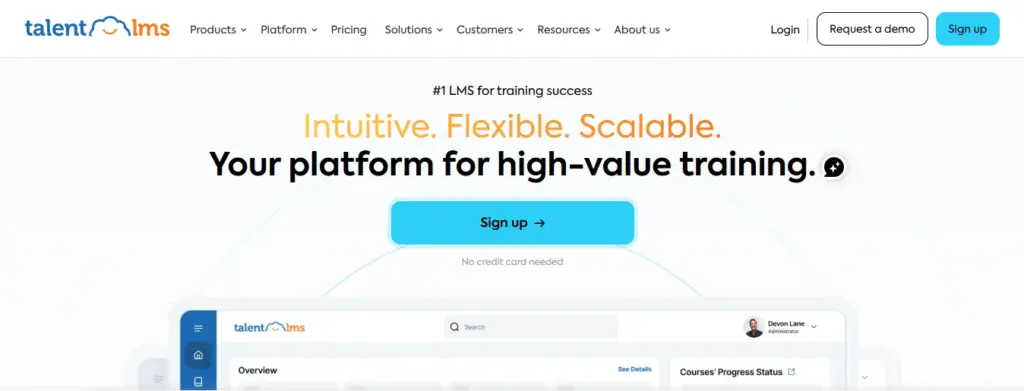
Key Features
- Course creation and upload (videos, PDFs, SCORM)
- Assignments, quizzes, assessments
- Learning paths and branching content
- Reports and analytics
- Multi-language support, white labeling
- Gamification (badges, leaderboards)
- Integrations and APIs
Pros
- Very user-friendly and fast to get started.
- Cost-effective for small/mid-size organizations.
- Clean interface with minimal training.
- Good for basic to moderate learning needs.
Cons
- May not have the depth of features required for large enterprises (e.g. complex compliance workflows, large scale user management).
- Customizations and advanced modules might cost extra.
- Analytics and reporting, though good for many, may not match enterprise LMS depth.
7. iSpring Learn
iSpring Learn is typically used together with iSpring authoring tools, making it strong for organisations that convert PowerPoint, slide decks or e-learning content into courses. It works well in organizations with a lot of existing content.

Key Features
- Easy publishing from PowerPoint into LMS courses
- Quizzes, interactions, assessments
- Learning paths and tracking
- Mobile apps and responsive design
- Reporting and analytics
- Supports SCORM, xAPI content
Pros
- Great for organizations with existing PPT content — conversion is simple.
- Tight integration with other iSpring tools.
- Clean and straightforward interface.
- Reliable for small to medium deployments.
Cons
- Might not have as many extra features (gamification, advanced social learning) as full-blown LMS systems.
- For very large or complex enterprises, scalability or enterprise-grade analytics may be limited.
- Customization and integrations may require technical support or additional development.
8. Docebo
Docebo is a global, enterprise-grade LMS with strong automation, AI elements, and deep analytics. It is used by many large organizations for sophisticated learning programs.
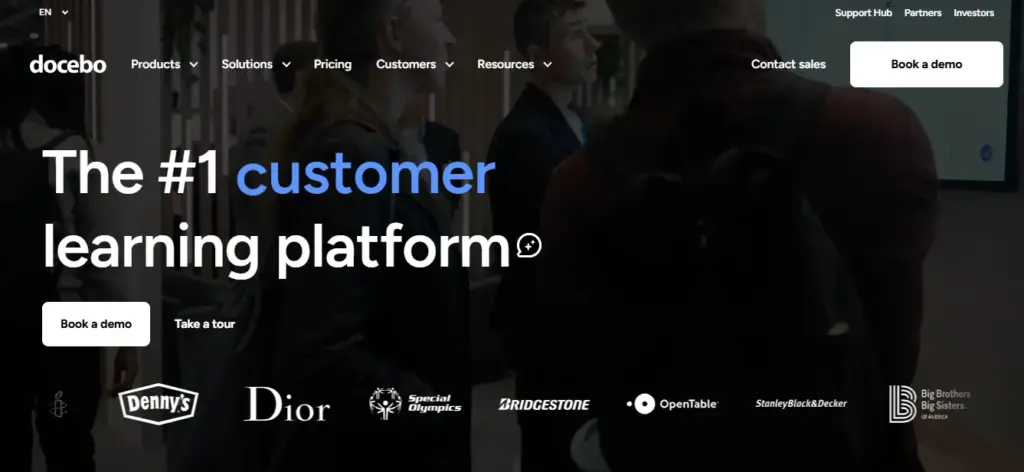
Key Features
- AI-powered recommendations and automation
- Learning paths, social learning, content management
- Extended enterprise (partners, customers) support
- Deep reporting and analytics
- Integrations with enterprise systems (HR, CRM)
- Mobile learning and offline support
Pros
- Very robust and scalable for large organizations.
- Advanced automation and AI help reduce manual effort.
- Good support for diverse learning use cases (internal training, partner training).
- Consistently rated among top LMS globally.
Cons
- Cost can be high for full-featured setups.
- Implementation and configuration require effort.
- For small teams or simple needs, much of its power may go unused.
9. Litmos
Litmos (by SAP) is a cloud LMS aimed at corporate training. It has been praised for its speed of deployment and useful out-of-the-box features.
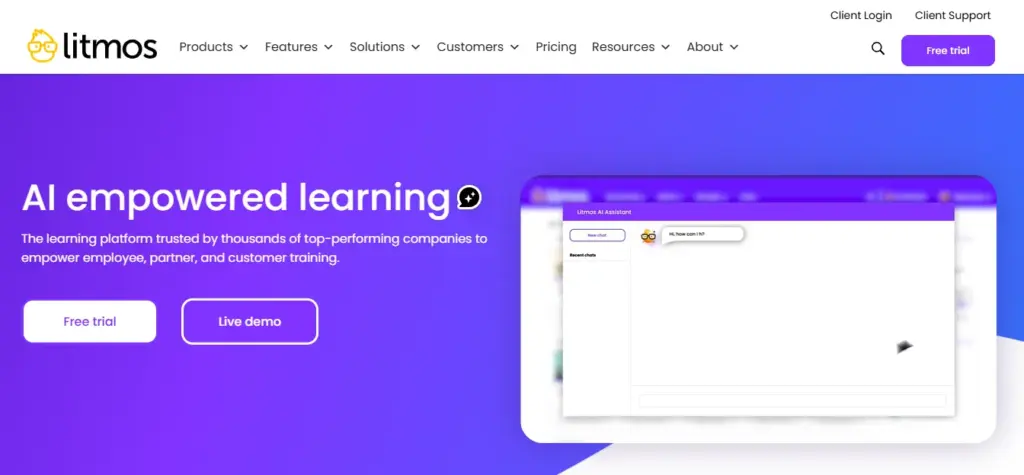
Key Features
- Pre-built course library
- Course creation, quizzes, assessments
- Mobile learning, offline modes
- Reporting and analytics
- Integrations with business tools and HR systems
- Gamification and social learning
Pros
- Fast deployment and ease of use.
- Good set of out-of-box training content.
- Suitable for corporate learning needs (sales, compliance, onboarding).
- Good balance of features vs. usability.
Cons
- Some features (especially advanced ones) may require add-ons.
- Customization beyond default may be limited or expensive.
- Analytics depth or custom reporting might be weaker compared to enterprise LMS.
10. SAP SuccessFactors Learning
SAP SuccessFactors is a comprehensive human capital management (HCM) suite, and its Learning module is part of this suite. It is made for large, global enterprises that want HR, talent and learning tightly integrated.
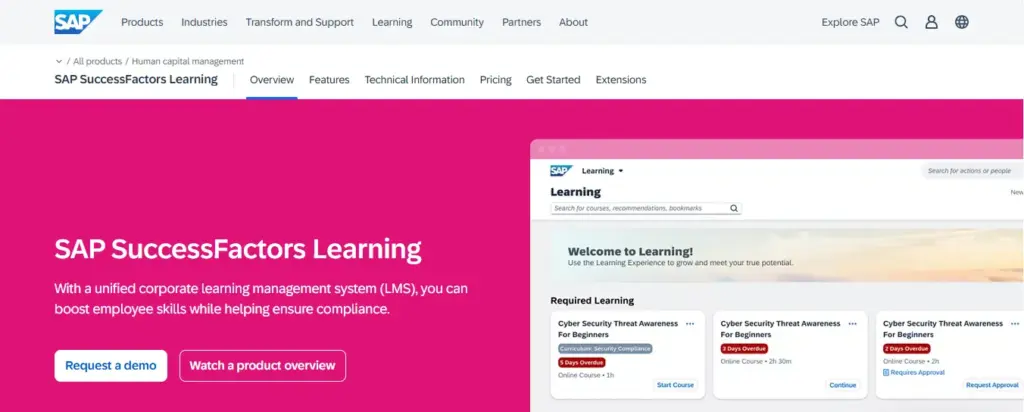
Key Features
- Global compliance and translations
- Deep integration with HR, performance, talent modules
- Learning paths, certifications, assessments
- Reporting, dashboards, analytics
- Extended enterprise training (partners, external learners)
- Mobile learning and offline support
Pros
- Excellent for organizations already using SAP in HR.
- Enterprise-level features and global scalability.
- Strong compliance support for regulated industries.
- Unified HR + learning platform reduces silos.
Cons
- Very high cost for licensing, implementation and customization.
- Complexity and long implementation cycles.
- Overkill for smaller companies or simpler learning needs.
11. Adobe Learning Manager (formerly Captivate Prime)
Adobe Learning Manager is an enterprise learning platform built to deliver formal learning, blended learning, and microlearning in a unified way. It is especially strong in content, since Adobe is a content and e-learning tools leader.
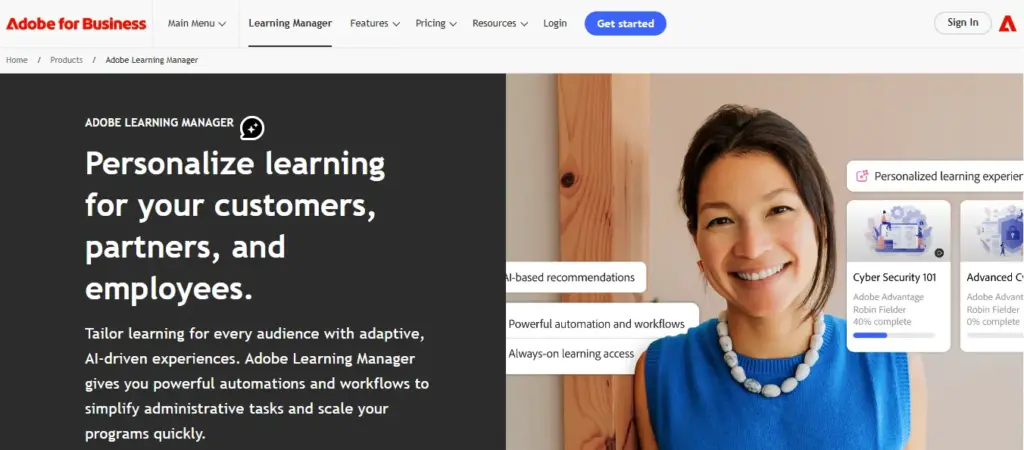
Key Features
- Course creation, content management, microlearning
- Blended learning, assessments, quizzes
- Analytics and dashboards
- Mobile and offline learning support
- Integration with Adobe tools and content tools
- Social and collaborative learning
Pros
- Strong content handling and design capabilities (given Adobe’s expertise).
- Good for organizations with large content needs.
- Reliable enterprise features and global support.
Cons
- License costs and maintenance may be high for small to medium companies.
- Learning curve for full use, especially for complex functionalities.
- For organizations not needing heavy content features, simpler LMS may suffice.
12. Zoho Learn
Zoho Learn is Zoho’s LMS offering, positioned for small to medium businesses and teams, often as part of the Zoho ecosystem (CRM, HR, etc.). It offers straightforward learning features without overwhelming complexity.
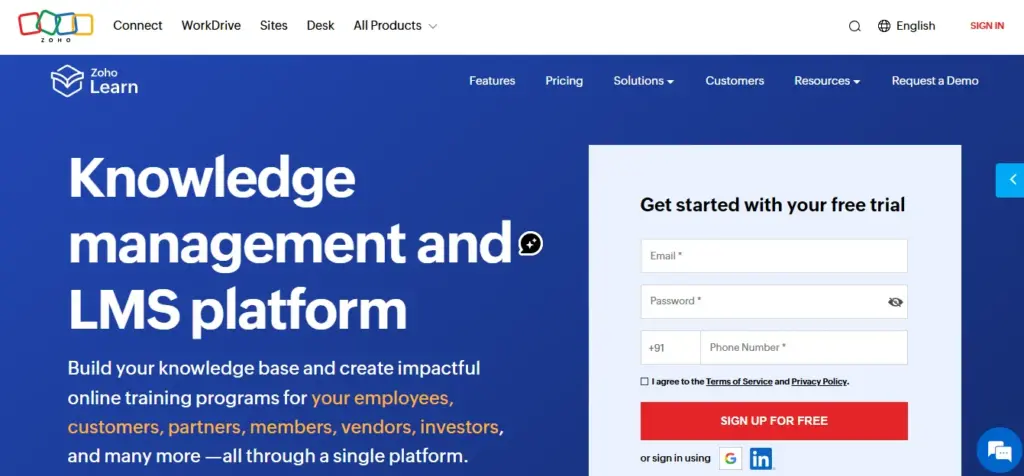
Key Features
- Course modules, lessons, quizzes
- Learning paths and drip content
- Analytics and reports
- Integration with Zoho suite (CRM, People, etc.)
- Mobile-enabled access
Pros
- Cost-effective and easy to use for small teams.
- Good for organizations already using Zoho apps (unified ecosystem).
- Simple, minimal interface helps speedy adoption.
Cons
- May lack advanced features found in enterprise LMS (deep analytics, partner training, very large user base handling).
- Fewer specialized features or third-party integrations.
- Might not scale as well for very large companies.
Need for Best Learning Management Software
Following are the main reasons why organisations of every size require the best learning management software in India:
1. Centralised Learning Hub
All training material is stored in one place. No more lost emails or scattered files. Learners log into one system to access everything they need.
2. Consistency in Training
Every learner gets the same quality of training – important for compliance, safety, and onboarding programs.
3. Time and Cost Efficiency
Rather than reserving rooms, printing content, or retaking sessions, courses are loaded once and used hundreds of times. This cuts cost and saves trainers’ time.
4. Tracking and Reporting
Managers have a real-time view of progress, who took a course, who passed, and who needs to complete. Reports can be exported for audits or performance reports.
5. Scalable Learning
Whether training 20 staff members in one city or 2,000 all over India, an LMS grows with your requirements without additional hassle.
6. Supports Remote and Hybrid Work
With staff distributed across locations, a cloud-based LMS enables staff to learn anywhere from their phone or laptop.
7. Better Employee Engagement
Features like gamification, leaderboards, and badges make learning more engaging, keeping employees motivated to upskill.
8. Compliance and Certification
Sectors such as healthcare, IT, and finance require periodic compliance training. An LMS ensures that everyone is kept updated and certified.
9. Continuous Growth and Retention
Employees desire career development. Providing easy access to courses based on skills makes them feel appreciated and want to work with the company longer.
10. Future-Ready Organisations
With automation, reporting, and HR system integration, the best LMS in India makes it easier for organisations to compete in the current knowledge economy.
Benefits of LMS for Employees
When organizations implement the best learning management system, the greatest beneficiaries are the employees. A quality LMS does not merely please the management with reports and compliance, it actually enhances the way employees learn, develop, and work. Let’s see the major advantages in detail:

1. Self-Paced Learning
Employees can take lessons at their own pace. Instead of rushing through a classroom session, they can pause, rewatch, or repeat sections until they understand fully.
2. Flexibility and Accessibility
With mobile-friendly LMS portals, employees can learn anytime and from anywhere – whether at their desk, at home, or on the go. This is especially useful for remote and hybrid teams.
3. Structured Learning Paths
The top LMS tools offer learning paths that present employees with step-by-step instructions. Beginner to advanced, employees have no idea what to learn next, making growth more transparent and structured.
4. Recognition and Motivation
Certificates, badges, and leaderboards give employees a sense of achievement. Recognition for completing courses encourages them to keep learning.
5. Improved Job Performance
Skills- and job-role-based training courses enable the workers to perform their jobs more efficiently and quickly. For instance, compliance training minimizes errors, and sales training increases conversion rates.
6. Faster Onboarding
For new hires, onboarding becomes smooth. Instead of depending on multiple managers or documents, new employees can access a ready-made module that explains company culture, policies, and basic skills.
7. Upskilling Opportunities
Employees are able to learn a range of training outside their immediate job. This assists them to develop in their profession, ready for promotion or additional responsibilities.
8. Better Work-Life Balance
Since employees can study on flexible schedules, they don’t feel forced into rigid classroom sessions outside work hours. This balance makes learning less stressful and more enjoyable.
In brief, the best learning management systems do not just make training convenient for the organisation but also enable employees to own their learning experience.
How to Choose the Best Learning Management System for Your Organization
Picking the ideal LMS platforms isn’t merely a matter of features, it’s a matter of fit. A feature that benefits a multinational may not benefit a small startup. This is an in-depth guide to assist you in making a good choice:
1. Define Your Goals
- Compliance training?
- Employee onboarding
- Upskilling and leadership development?
Understanding your purpose allows you to shortlist suitable learning management software.
2. Ease of Use
The simpler the LMS interface, the better. Complicated platforms reduce adoption rates. Choose one with a clean, user-friendly design.
3. Content Compatibility
Ensure the LMS supports your formats; videos, PDFs, SCORM, quizzes, live sessions. If your training relies heavily on presentations, look for tools like zimyo.
4. Scalability
Think big but start small. The ideal LMS in India must scale with your business—50 users to 5,000 users.
5. Reports and Analytics
Tracking completion, test results, and being able to create custom reports is critical for HR departments and managers.
6. Mobile and Offline Access
With workers frequently not in the office, an app on the mobile device or offline capability is essential.
7. Integration with Other Systems
The best LMS must integrate with your HRMS, payroll, or performance management system. This eliminates double entry and streamlines reporting.
8. Budget and Pricing Model
Compare cost-per-user, monthly vs. yearly plans, and whether you pay for active learners only. Choose what works in your budget.
9. Local Support and Language Options
For Indian businesses, local support and local language content can be a huge boon.
10. Free Trial or Demo
Always test before buying. Let a small team use the system for a week or two and collect feedback.
Friendly Tip: Don’t chase the “most popular” LMS – choose the one that fits your team’s unique needs.
Why organisations choose Zimyo:
Rather than having stand-alone tools for HR, payroll, and learning, Zimyo consolidates everything under one umbrella. For Indian businesses seeking the best LMS coupled with HRMS, Zimyo is one of the best options.
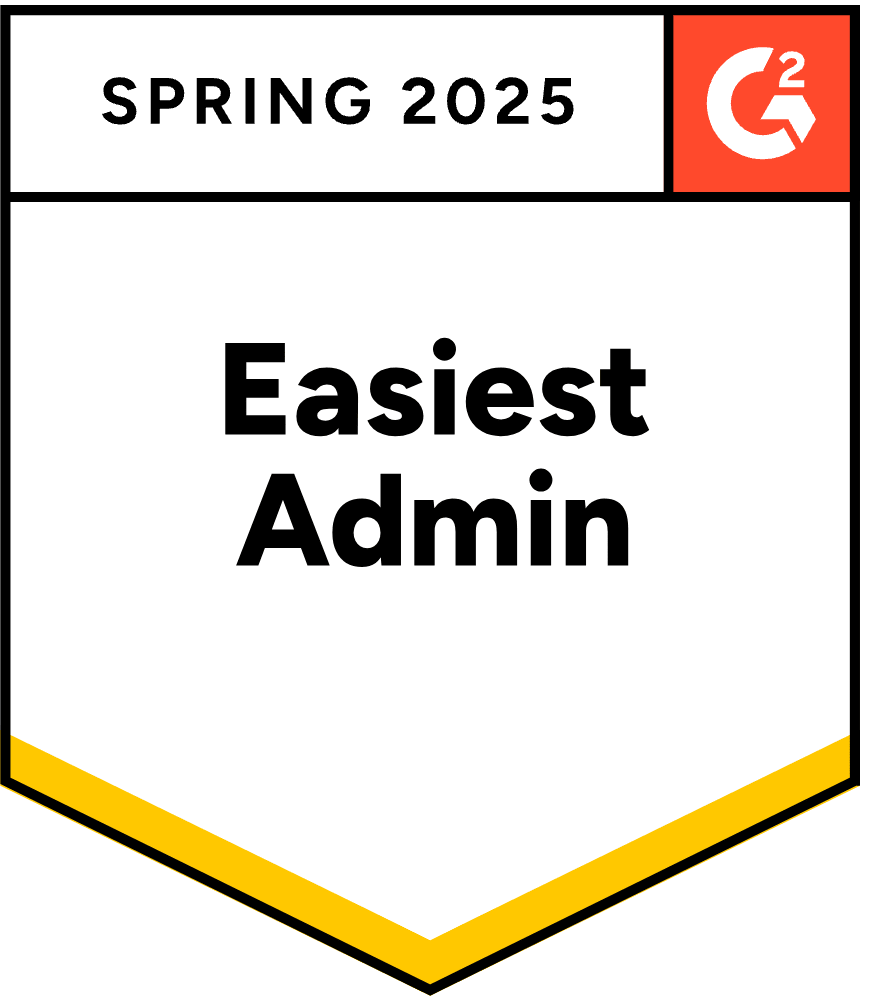
Conclusion
The function of the top learning management system has never been more vital. It’s no longer only about compliance or hosting training videos; it’s about making a culture of ongoing learning and development.
Through this guide, we learned:
- What an LMS is and why it is important.
- The obvious advantages employees gain from utilizing the high-rated LMS platforms.
- The best 12 learning management systems in India, each with their strengths.
- How Zimyo is different with its HR + LMS integrated solution.
- Practical insights on how to choose the appropriate learning management solutions for your organization.
If you are a small business or a multinational company Zimyo is a good bet.
The path to creating a competent workforce begins with the right platform. Take your time, consider options, and spend in the finest LMS that enables your people to learn, grow, and thrive.
Frequently Asked Questions (FAQs)
Which is the best learning management system in India?
There is no single best LMS for all use cases. For corporate training and employee development, platforms like Docebo and TalentLMS are highly rated. Many organizations also choose Zimyo’s learning module because it integrates with HR functions, onboarding, and performance management.
Which learning management system is best?
The best LMS depends on the need. For companies that want automation, analytics and skill mapping Docebo, TalentLMS and Zimyo’s LMS module are strong options.
Which is the No 1 learning platform in India?
Moodle and SWAYAM are among the most widely used platforms in India. In corporate HR teams prefer Zimyo if they want both HR and learning tools under one system.
What is the LMS system in India?
An LMS in India is a digital platform that helps educational institutions and companies create, deliver, and manage training programs. It supports online courses, assessments, progress tracking and certification.
Is Google LMS free?
Google Classroom is free for basic educational use. Some advanced features are available only through Google Workspace for Education plans.
Is SWAYAM free or paid?
SWAYAM content is free to access. If a learner wants an official certificate there is a small exam fee.

